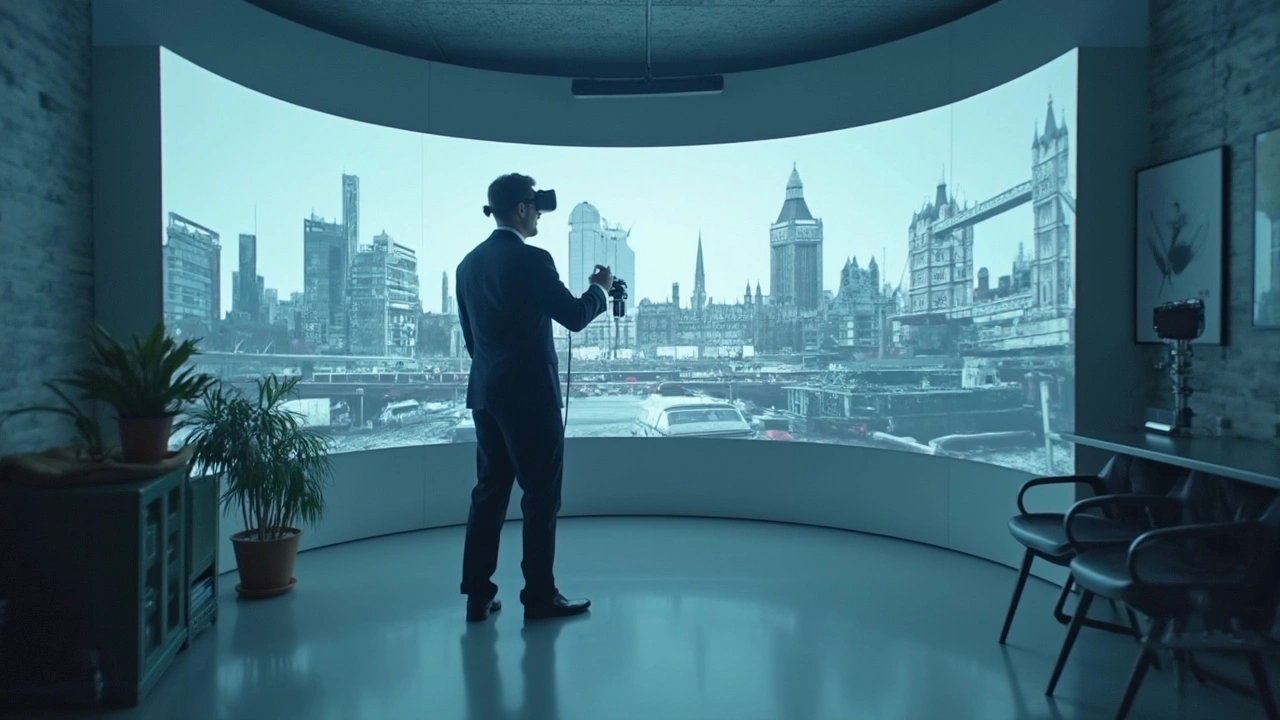When we talk about virtual reality, there are three main types that pop up: non-immersive, semi-immersive, and fully immersive. Sounds technical, right? Let's break it down because each type has its own flair and purpose.
First up, non-immersive VR. You might have already experienced this if you’ve ever played a video game using a regular screen. It involves using a conventional computer setup where you interact through controls like keyboards and mice. It's about enhancing your experience without cutting you off from the real world. Pretty neat for those who want to keep one foot in reality.
Non-Immersive VR
Non-immersive VR might not sound as thrilling as those full-blown headsets you see, but it's a solid start for anyone new to virtual reality. Think of it as a more enhanced version of your typical computer experience. You're not entirely leaving the real world behind, as your environment is very much around you.
This type mainly involves interacting with a virtual environment through a computer setup, using a screen, keyboard, and mouse. Yep, it's what you might be doing every day if you game or work on a PC. What's cool about non-immersive VR is that it offers a bit of a virtual twist without overwhelming your senses entirely.
It's great for simulations and educational purposes. Now, imagine training airline staff or teaching in classrooms with interactive programs; they're heavily reliant on non-immersive setups. It's practical, especially in situations where safety or cost makes real-life training challenging.
| Advantages | Disadvantages |
|---|---|
| Cost-effective | Lower immersion |
| Minimal equipment | Limited realism |
If you're considering trying out VR experiences at home but aren't ready to invest big bucks, non-immersive setups using your current tech are a no-brainer.
Semi-Immersive VR
Semi-immersive VR is like that perfect middle ground between peeking into a screen and diving into a new world completely. Think of it as the best of both worlds—with more depth than your standard PC game, but not so intense that you lose track of reality.
This type of virtual reality experience often involves large screens or projector systems, sometimes paired with structured environments like simulators. Ever heard of flight simulators used for pilot training? That's semi-immersive VR in action, providing realistic flight experiences to practice without leaving the ground. It's a vital tool in sectors like aviation and even astronomy, where exploration happens in a controlled setting.
"Semi-immersive VR provides an invaluable bridge between fully immersive experiences and traditional learning methods, offering both depth and context," said Dr. Elisa Grey, a leading researcher in immersive technologies.
What makes semi-immersive VR fascinating is its balance—it allows ample interaction while minimizing the cost and complexity associated with full immersion setups. With this, users can enjoy a sense of presence, an experience that's a step up from non-immersive VR experiences.
Here are some key features of semi-immersive experiences:
- Large-screen displays or projectors for immersive visuals.
- Minimal additional equipment needed, often avoiding headsets.
- Utilization in training simulations for real-world skills.
The technology is a staple in educational settings too. It offers an engaging way to learn new concepts without the high-end costs of fully immersive systems. While it's not as captivatingly complete as fully immersive VR, semi-immersive setups are highly effective and versatile in plenty of real-world applications. So next time you hear about VR, think of it as a spectrum, with semi-immersive being that 'just right' Goldilocks choice for many.

Fully Immersive VR
So, what’s the big deal with fully immersive VR? Think of it as diving headfirst into a new world—the crème de la crème of virtual reality experiences. With fully immersive VR, you’re not just a player on the sideline; you’re right in the heart of the action.
This type of VR requires some high-tech gear. Most setups include a head-mounted display (HMD), which is basically goggles packed with screens and sensors, motion detectors, and sometimes even haptic (touch-based) feedback systems. These tools trick your brain into thinking what you're seeing is real, providing a 360-degree view that changes as you move your head. Talk about mind-blowing!
Did you know? According to recent tech reports, as of 2023, sales of fully immersive VR headsets have surged by over 30% year-on-year, showing just how popular this technology is becoming.
| Year | Headset Sales Growth |
|---|---|
| 2022 | 25% |
| 2023 | 30% |
Why do people love it? Fully immersive VR can transport users to all sorts of places. Whether it’s exploring ancient ruins, battling in outer space, or even conducting detailed architectural walkthroughs, the potential uses are vast. It’s not just for gamers; industries like real estate, healthcare, and education are tapping into the power of fully immersive experiences for training, planning, and education.
- Gaming: Get inside the game like never before.
- Training: Simulate real-world scenarios for pilots or surgeons.
- Education: Travel through history or the human body without leaving the classroom.
It's no wonder that everyone from big industry players like Meta and Sony to indie developers are jumping in, crafting experiences that range from the fantastical to the deeply practical. As the tech keeps improving, who knows what new worlds we'll get to explore next?
Choosing the Right VR Experience
So, you're thinking about diving into the world of virtual reality, but you're not sure which type is your cup of tea? It's cool, we've all been there. The key is to figure out what you want from your VR experience. Here’s a cheat sheet to help you decide.
If you’re just dipping your toes in, non-immersive VR is a good start. You get the added layers of augmented reality without leaving your comfort zone. Simple gaming rigs or productivity tools are examples here.
Want to get a bit more involved? Semi-immersive VR is your middle ground. It’s like upgrading from a regular movie to IMAX. You might use a head-mounted display, and it’s fantastic for educational or simulation purposes. Think flight simulators or interactive museum tours.
Fully immersive VR is for the brave-hearted. You’ll need some heavy-duty gear like a VR headset, gloves, maybe even a suit. It’s your go-to for a completely different world experience, perfect for hardcore gamers or specialized training like surgery simulations.
"The best VR experience depends on your needs and preferences, whether you’re looking for education, entertainment, or professional training," says John Carmack, a pioneer in the VR field.
Here are some factors to keep in mind when choosing:
- Budget: VR setups range from affordable to high-end. Know your budget and stick to it.
- Space: Fully immersive setups might need more room. Clear out that living room!
- Purpose: Understand what you need. Is it for gaming, training, or casual exploration?
Want some stats? Here’s a quick look at what people are using their VR systems for:
| Use Case | Percentage |
|---|---|
| Gaming | 55% |
| Professional Training | 20% |
| Educational Purposes | 15% |
| Other (Social, Art, etc.) | 10% |
In the end, it boils down to what you’re after. Stick with what complements your lifestyle and interests, and you'll have a blast in the world of immersive tech.

